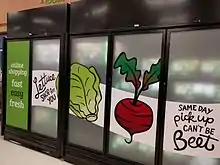Online grocer
An online grocer is either a brick-and-mortar supermarket or grocery store that allows online ordering, or a standalone e-commerce service that includes grocery items.[1][2] There is usually a delivery charge for this service. Online grocery delivery services are available throughout Europe, Asia and North America, mostly in urban centres. The online ordering is done through e-commerce websites or mobile apps.
| series on |
| E-commerce |
|---|
| Online goods and services |
| Retail services |
| Marketplace services |
| Mobile commerce |
| Customer service |
| E-procurement |
| Purchase-to-pay |
In-store pickup

For brick-and-mortar stores that have online ordering, customers can place orders online and pick up their ready orders in the store on their way home. In-store pickup — sometimes termed "click & collect" – is typically offered for same-day shopping; it is usually less expensive than delivery, and can be done at a time of the customer's choosing. This option is popular in rural areas. It is also useful for customers living outside of the store's local delivery area.
Local delivery
Most local online grocers have their own drivers. The most common type of personal delivery involves storing grocery inventory in a warehouse to deliver to customers once orders are placed. Another type of personal delivery which is less common is based on just-in-time business in which there is no warehouse or inventory. In this type of delivery, customers place orders for next-day delivery. The online grocer shops for the groceries on the morning of the delivery day.
Some grocery fulfilment centres are set up as dark stores. Online-only grocers typically have warehouses or distribution centers nearby, to allow local shipping of refrigerated items.
Online grocers with a large regional or national delivery area may ship groceries using courier services. If the order contains cold or frozen items, this involves "flash freezing" the goods and pack them into special shipping containers.
Companies have experimented with automated delivery modes including drone delivery and robots. For instance, in Fall 2016 Washingthon D.C. approved a trial run of rolling delivery drones produced by Starship Technologies. The earthbound robots are similar to wheeled coolers and carry around 40 pounds of groceries.[3]
Platforms
The online grocer technology platform could be developed in-house, or a third party's platform could be re-used and customized to reflect the company brand and provide unique features. In some cases, all management and support tasks are being outsourced to the platform provider.
Market size and share
In the United States, as of 2017, Amazon.com sold $2 billion worth of groceries online. It had the largest market share, 18%, followed by Walmart.[4] It has partnered with Whole Foods Market.[5]
The value of the US online grocery market has grown from $12 billion in 2016 to $26 billion in 2018 and it has plenty of room to grow, given that the size of the overall grocery market was $632 billion in 2018 according to IBISWorld.[6]
Online grocery shopping has grown substantially during the COVID-19 pandemic.[7]
Impact on the environment
Online grocery stores may allow facilitating local food which may reduce the environmental impact of food transport. Small-scale farmers have been embracing digital technologies as a way to directly sell produce, and community-supported agriculture and direct-sell delivery systems are on the rise during the coronavirus pandemic.[8] Furthermore, weekly grocery deliveries can be a better choice than individual trips to a store.[9]
Some online grocery stores have a goal of supporting the production and sale of fresh, organic, locally grown, sustainable foods.[10]
References
- http://www.padgadget.com/2011/01/11/peapod-brings-online-grocery-shopping-service-to-ipad/, Peapod Brings Online Grocery Shopping Service to iPad, Pad Gadget, January 11, 2011, Retrieved February 1, 2011.
- http://www.logisticsmanager.com/Articles/15470/Online+grocer+heads+towards+profit+.html Archived 2014-12-13 at the Wayback Machine, Online grocer heads towards profit Published: 01 February 2011 03:51 PM, Retrieved February 1, 2011.
- Etherington, Darrell. "Grocery deliveries via rolling drone will kick off in Washington, D.C. this fall". TechCrunch. Retrieved 2017-11-08.
- Amazon led the US in online grocery in 2017
- Amazon and Whole Foods after a year
- Magana. "THE ONLINE GROCERY REPORT: The market, drivers, key players, and opportunities in a rising segment of e-commerce". businessinsider. Magana.
- "Coronavirus will change the grocery industry forever". CNN. Retrieved 26 May 2020.
- Foote, Natasha (2 April 2020). "Innovation spurred by COVID-19 crisis highlights 'potential of small-scale farmers'".
- "Delivery disaster: the hidden environmental cost of your online shopping". the Guardian. 17 February 2020. Retrieved 26 May 2020.
- "Amid Pandemic, Local Company Delivering Meat And Fresh, Organic Sustainable Foods". 22 May 2020. Retrieved 26 May 2020.